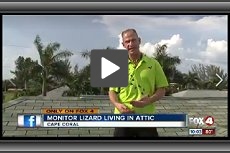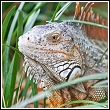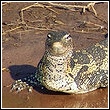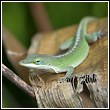Cape Coral Nile Monitor Control
Nile Monitor Project - Fox 4 News Coverage
The Wildlife Whisperer recently made the news when Ned Bruha was called in to solve a family's apparent Nile monitor problem.
It is not uncommon for iguanas, Nile monitors and other lizards to invade attics in search of food and shelter.
Larger lizards like the ones troubling this homeowner, can tear their way through a roof and be inside your home before you know it.
Regarding this story, after investigating the situation further, Bruha and the Wildlife Whisperer's reptile expert Jim Pellerin, discovered this family didn't have a Nile monitor in their attic, but rather they had a group of 3 to 6 large iguanas, also known as a "mess" of iguanas.
For more information related to this story please visit our sections on lizard control, iguanas, and identifying Nile monitors.
Trapping alone will only solve the problem temporarily.
The Wildlife Whisperer, Inc. goes beyond simply removing Nile monitors and other large lizards such as iguanas, we also have the equipment, expertise and support network to help you identify the cause of the problem, fix it and prevent future problems too.
Cape Coral's Nile Monitor Problem
It's uncertain as to when the first Nile monitors arrived in Florida, but sightings began around 1990. It is most likely that they were originally brought over as a pet, only to escape or be released when their owners found them too difficult to care for.
Nile monitors are great swimmers and drawn to areas with plenty of water where they can swim and hunt. Take the canals around Cape Coral, combined with the lush vegetation, and the area gave them just what they were looking for - food, shelter and lots of water.

Once released in the early 1990's, their population grew rapidly. This is because there are few natural population control factors in place to keep their numbers down, they grow quickly and begin breeding at an early age, laying around 60 eggs per clutch.
Today, there are believed to be over 1000 Nile monitors in the Cape Coral area, and they have become a very big problem for area residents.
The Nile monitor is a very large lizard, it is the largest lizard in Africa and grows to around 5', sometimes reaching over 7'. They are intelligent, active and very predatory.
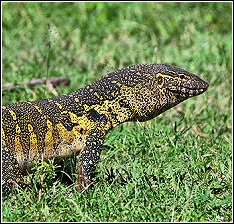
Trapping, Removal and/or Exclusion
They hunt by day and will not hesitate to go after a small dog or cat. The will also eat beloved wildlife species such as the burrowing owl and gopher tortoise. Nile monitors have strong tails that can hurt when they strike and a bite that can do some serious damage, even crush bones.
Nile monitors have sharp claws and very sharp teeth. They are considered a venomous lizard, their saliva can make you very sick - if you are bitten you should seek help immediately.
Nile monitors also dig large burrows, usually close to the canals, which can compromise the sea wall. They can also create havoc and become a nuisance when they get into trash.
Nile Monitor Removal
The population has grown so large that the idea of completely getting rid of Nile monitors in Cape Coral has somewhat been abandoned. Consequently, the state is focusing more on control efforts these days, which include Nile monitor trapping and removal, as opposed to complete eradication.
Nile monitors aren't necessarily easy to catch or trap - they are fast runners, adept climbers, great swimmers and highly intelligent.
Catching a Nile monitors isn't something the average homeowner should try as a DIY project.
There are a few options if you have a Nile monitor problem around your home. The Environmental Resources Division conducts a trapping program, if you are having a Nile monitor problem in Cape Coral, you can give them a call at (239) 574-0785. If you prefer to call a private trapper, the Wildlife Whisperer offers Nile monitor removal services and can help get rid of them for you.
Regardless of what avenue you decide to utilize, it will be important to follow removal up with the proper modifications to your home to repair damage and exclude them from getting back in - or more will come in soon to take their place.
We can help you with all your Nile monitor removal and prevention needs from start to finish, from identifying the cause and severity of the problem, to removal and repairs, to exclusion and prevention of further issues.
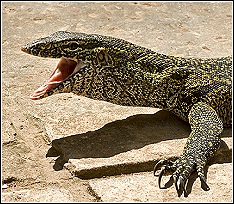
Identifying Nile Monitors
If you are trying to locate a Nile monitor around your home it might be helpful to know they usually build their burrows close to a canal, and spend a lot of time swimming in the water or basking in the sun.
Nile monitors, as seen below, are sometimes mistaken for other lizards and vice versa. But if you know what to look for, Nile monitors are actually pretty distinguishable due to their characteristic markings.
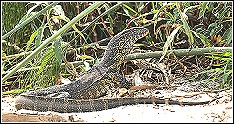
Iguanas tend to be green, brown or blackish with blackish bands around their bodies and/or tails. Whereas monitors are black with yellow spots. It could be said that a Nile monitor's markings are of a banded nature but iguanas don't quite have the spotted pattern that Nile monitors do. Another way to tell them apart - iguanas, like the one in the first photo shown immediately below, have a spiny appearance on their back, whereas Nile monitors do not. The Tegu lizard, like the one seen in the second photo below, might be a bit easier to mistake for a young Nile monitor than an iguana would be, as the markings on a Tegu are more similar. Tegus are shorter, usually 2' to 3' in length. On occasion, a Nile monitor, especially a larger one, may be mistaken for an alligator.
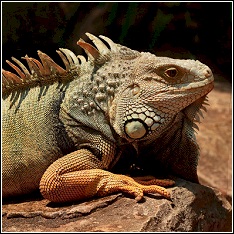
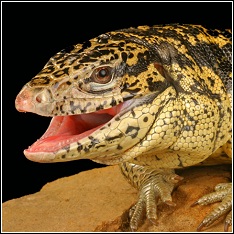
If you are having problems with large lizards and not sure of the cause, we have the equipment and experts available to identify exactly what kind of lizard is creating the problem.
1242 SW Pine Island Rd., Suite 310
Cape Coral, Florida 33991-2126
help@totalwildlifecontrol.com



